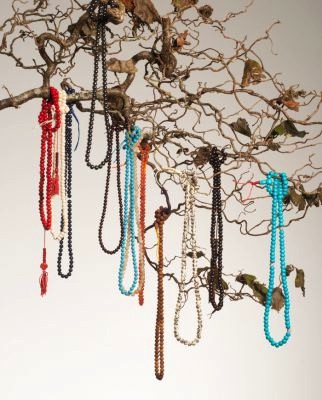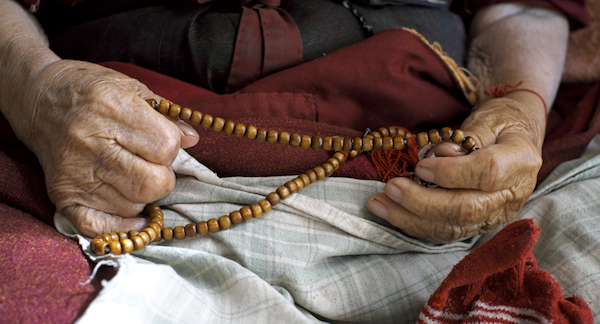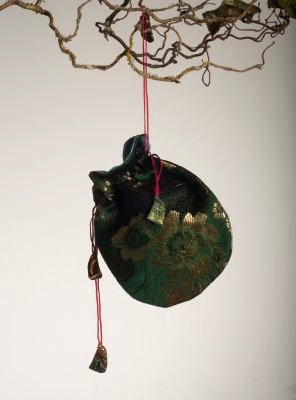Some of our most popular items in the Tibetan Nuns Project online store are our malas or Buddhist prayer beads. The Tibetan Buddhist nuns at Dolma Ling Nunnery and Institute near Dharamsala, India make our long malas and bless both the long and wrist malas.

A selection of the Tibetan malas made and blessed by Buddhist nuns and available through our online store.
Mala is a Sanskrit word meaning “garland”; in Tibetan, a mala is called threngwa. Malas are used to keep track while one recites, chants, or mentally repeats a mantra or the name or names of a deity. Malas are similar to other forms of prayer beads used in various world religions and they are sometimes called the Buddhist rosary. They are employed to focus one’s awareness and concentration during spiritual practice.
Mantras are spiritual syllables or prayers and are usually repeated many times. In Tibetan Buddhism, one mala constitutes 100 recitations of a mantra. There are 8 additional recitations done to ensure proper concentration. One holds the mala with the left hand and begins to recite from the guru bead, clockwise around the mala.
In Tibetan Buddhism, people traditionally use malas with 108 counting beads and a formal, special, three-holed, finishing bead called a “guru” bead or “Buddha” bead. Often the 108-bead malas have additional marker beads that may or may not be counted and that divide the mala into quadrants, constituting a sum of 108 counting beads.
How to hold and care for your mala
The mala is held with gentleness and respect, generally in the left hand. One bead is counted for each recitation of the mantra, starting with the first bead after the “guru” bead, which is the larger, more decorative bead at the mala’s end. The first bead is held between the index finger and thumb, and with each recitation of the mantra you move your thumb to pull another bead in place over the index finger.
Once you have completed a full circuit of the mala and reached the guru bead again, you reverse direction by flipping your mala. Then you continue again in reverse order. Most people believe that you do not cross over the guru bead as a sign of respect towards one’s spiritual teachers.

An elderly nun at Geden Choeling Nunnery in Dharamsala, India gently holds her Tibetan mala. Photo courtesy of Brian Harris
Malas are sacred objects believed to be charged with the energy of the deity. They should be treated with great reverence. The nuns at Dolma Ling Nunnery and Institute also make and sell mala bags so that malas can be carefully protected.

A green brocade mala bag made by the nuns at Dolma Ling Nunnery. Our online store has a range of bags made in different fabrics and colors.
As with all sacred objects, such as books and other spiritual instruments, one should keep malas off the ground. If your mala accidentally lands on the ground, you should touch it to the crown of your head and recite the sacred syllables Om Ah Hum, three times.
The mala should not be worn while bathing, or allowed to get wet, as this may weaken the cord on which the mala beads are strung. It is best also if you remove your mala before going to sleep so that you do not accidentally exert stress on the cord and cause it to break.
Choosing a Mala
The Tibetan Nuns Project has different kinds of long malas, each hand strung, knotted, and blessed by nuns at Dolma Ling Nunnery and Institute near Dharamsala in India. They are made from natural materials such as semiprecious stones, sandalwood, and bone and they range in price from $15 to $45.
Long malas can be worn as a necklace or wrapped around your wrist. By purchasing these malas, you are also helping to support the nuns with food, shelter, education, and health care – something you can feel great about every time you use your mala. You don’t have to be a Buddhist to wear a mala.
Our online store also has many types of wrist malas ranging in price from $11 to $22, also made and blessed by the nuns at Dolma Ling. The wrist malas are approximately 6 inches (15 cm) in diameter and strung on elastic to fit most wrists.
Types of Malas
Here’s a list of some types of malas and their special properties:
Amethyst is the stone of spirituality and contentment. It balances the energy of one’s intellectual, emotional, and physical bodies.
Garnet enhances one’s internal fire and brings about creative power. It is helpful during moods of abandonment and brings freshness to one’s life.
Granite helps with balance in relationships and cooperative efforts and facilitates diplomacy. It helps bring an increase in money while allowing the person to retain modesty.
Jade assists in analyzing dreams and brings the user a long and fruitful life. It helps with the transition from this body to the spiritual world.
Lapis provides objectivity, clarity, and mental endurance during times of realizing emotions. It also helps with creativity, organization, and depression.
Malachite creates an unobstructed path leading to a desired goal and helps one accept responsibility for actions and circumstances.
Moonstone is balancing, introspective, and reflective. It helps with the changing of one’s life emotionally, mentally, physically, and spiritually and helps to recognize “ups and downs.”
Pearl signifies faith, charity, and innocence. It enhances personal integrity and provides focus and is used to increase fertility and ease childbirth.
Quartz amplifies body and thought energy. It also brings the energy of the stars to the body.
Rose quartz creates harmony and self-love during chaotic situations. It is the stone of gentle love and brings peace to relationships.
Sandstone builds and strengthens relationships and/or groups. It provides insight into deceit and encourages truth.
Tiger eye brings about clarity when dealing with scattered intellectual fragments that must be brought together. This stone is practical and grounding.
Turquoise heals the spirit with soothing energy and provides peace-of-mind. It holds both spiritual and protective properties, and balances the male and female aspects of one’s character.

Hi I’m looking into buying my partner some prayer beads. I’ve been reading on this site about LAPIS which is gd for mental health ?
Can you get prayer beads in this ? And also do you bless them ?
Many thanks
Hi Keri,
Thank you for your question. The long malas come in lapis, here is the link. You can also read here about some of the properties folks assign to different stones: https://tnp.org/product/mala-page-example/. All of our products are blessed by the nuns, yes.
Warm wishes,
Lisa
i usually wear my wrist mala any time i go out, or during the day at home. if i have recently received HH Dalai Lama’s kalachakra initiation, and am now practicing the commitment deity practices, may i use this mala for that, or should my practice mala not be worn outside?
Dear Sora, Thank you for your question. It is fine to wear a wrist mala at any time, indoors or out. And it can be used for daily commitments.
thank you so much!
I’m happy to know i can wear it all the time 🙂
Just found out I posted my question on the Dalai Lama’s BIRTHDAY. Happy Birthday your Holiness and I hope all your Birthday wishes come true. Have a Blessed day! Take care- be well
Hello,
Can you please explain the differences between lapis composite and lapis solid? Both in color and strength of stone/power to impact practice.
Thank you,
D
Dear Danielle, The lapis solid is a stone that is mined and is, therefore, a whole stone bead which has been polished. The composite lapis is a bead made of tiny pieces of lapis stone, compressed together, we believe that some dye is added to this. There are images on the long mala page of the website.
Hi bought a lapis Mala bracelet for my mum for healing. Should she wear on right hand or left hand! Thanks😘
Thank you, Shirley, and we send best wishes to you and your mother for health and happiness. It is better to wear the mala on the left wrist.